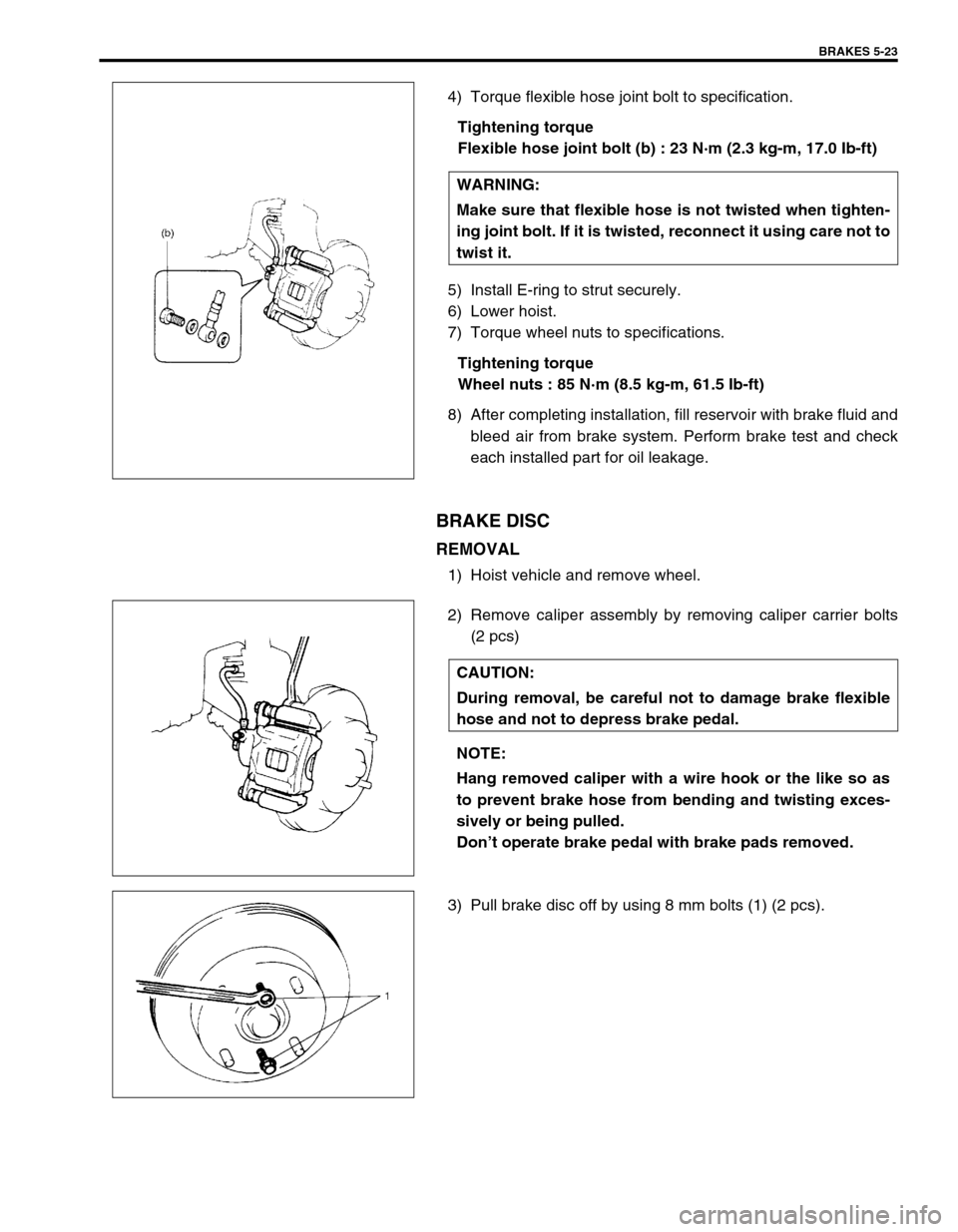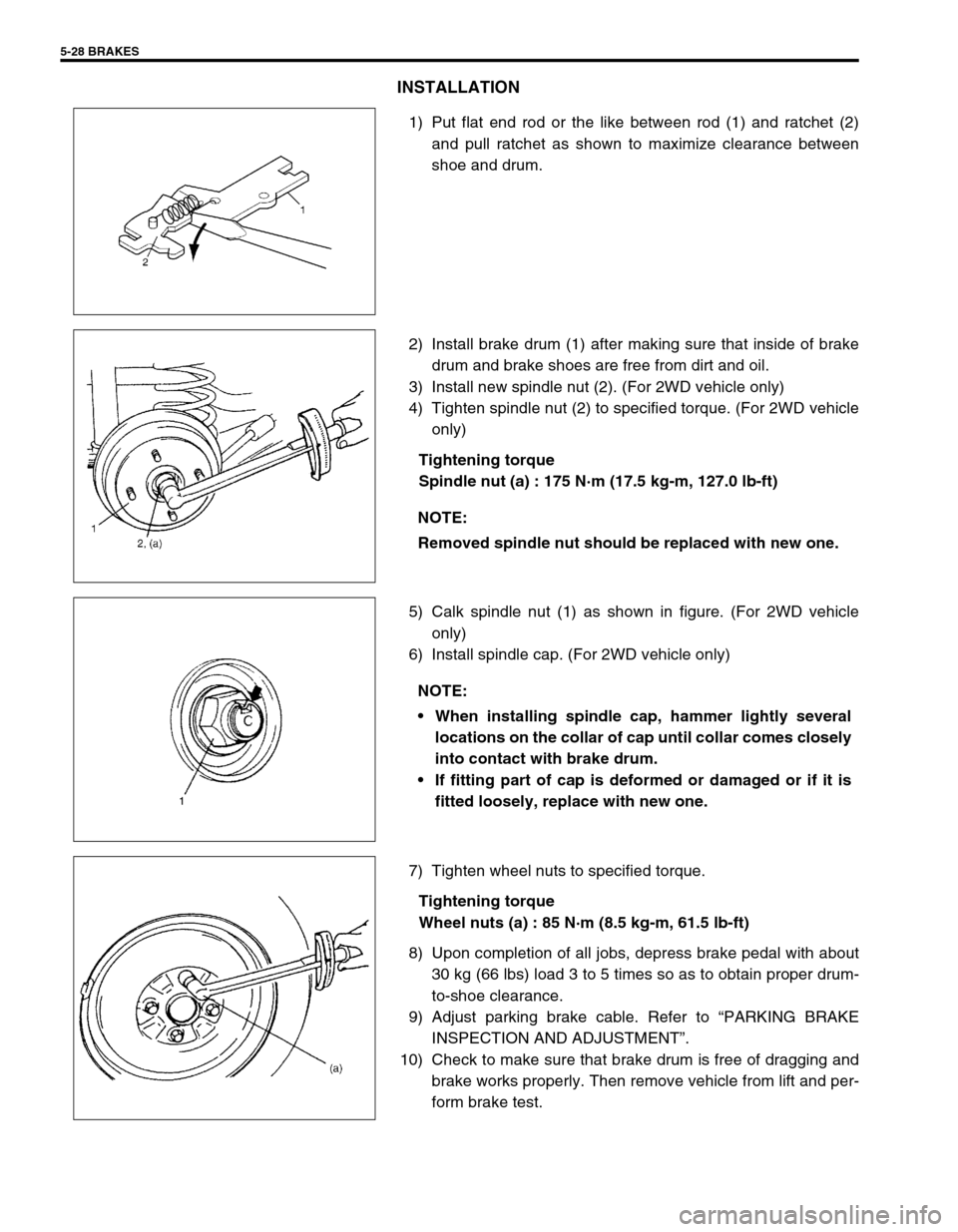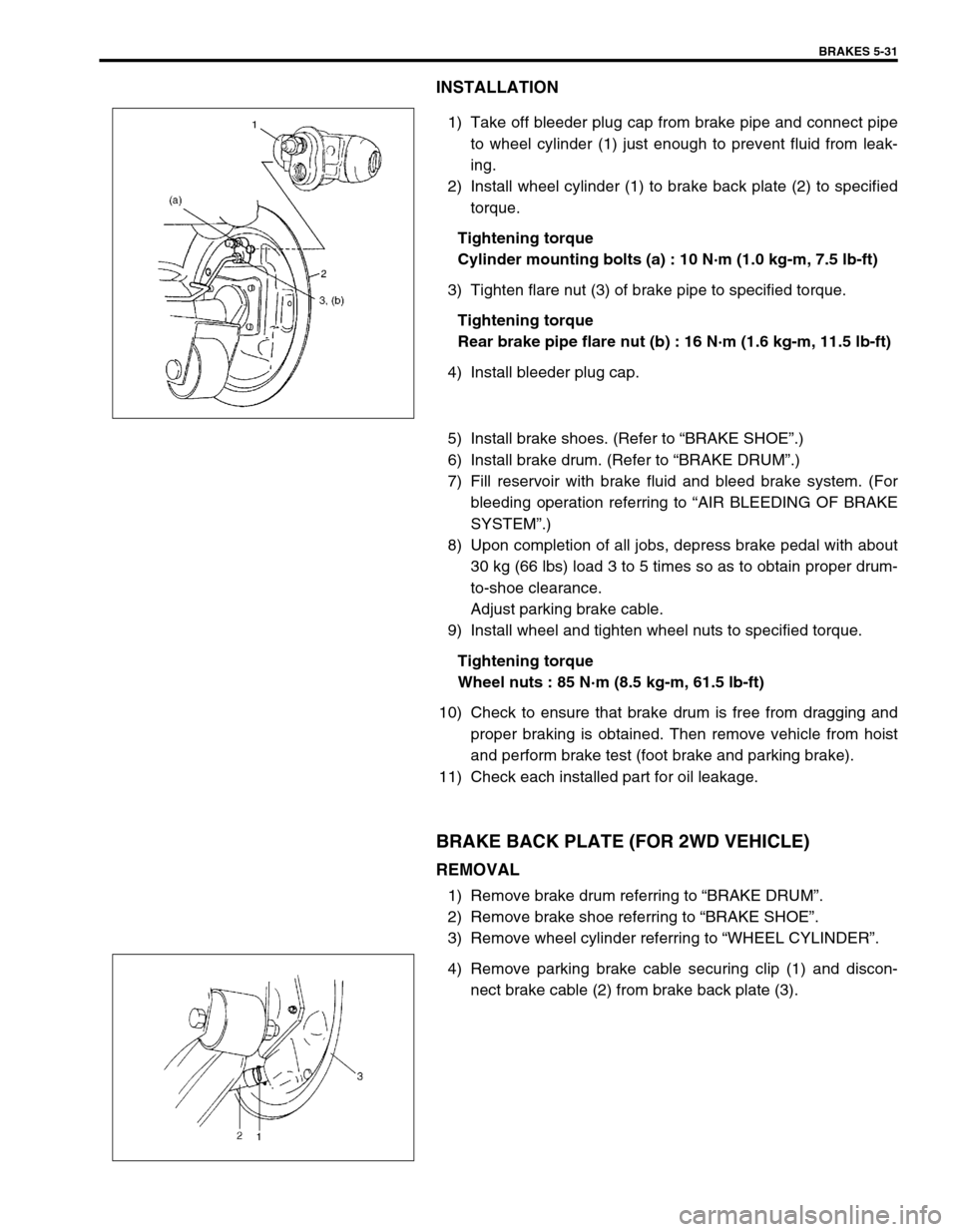Page 296 of 698

BRAKES 5-23
4) Torque flexible hose joint bolt to specification.
Tightening torque
Flexible hose joint bolt (b) : 23 N·m (2.3 kg-m, 17.0 Ib-ft)
5) Install E-ring to strut securely.
6) Lower hoist.
7) Torque wheel nuts to specifications.
Tightening torque
Wheel nuts : 85 N·m (8.5 kg-m, 61.5 Ib-ft)
8) After completing installation, fill reservoir with brake fluid and
bleed air from brake system. Perform brake test and check
each installed part for oil leakage.
BRAKE DISC
REMOVAL
1) Hoist vehicle and remove wheel.
2) Remove caliper assembly by removing caliper carrier bolts
(2 pcs)
3) Pull brake disc off by using 8 mm bolts (1) (2 pcs).WARNING:
Make sure that flexible hose is not twisted when tighten-
ing joint bolt. If it is twisted, reconnect it using care not to
twist it.
CAUTION:
During removal, be careful not to damage brake flexible
hose and not to depress brake pedal.
NOTE:
Hang removed caliper with a wire hook or the like so as
to prevent brake hose from bending and twisting exces-
sively or being pulled.
Don’t operate brake pedal with brake pads removed.
Page 297 of 698
5-24 BRAKES
INSPECTION
Using magnetic stand and with dial gauge positioned at
about 10 mm (0.39 in.) inward from periphery of disc, mea-
sure deflection of disc.
If limit value is exceeded, replace correct or replace.
Disc deflection
Limit : 0.10 mm (0.004 in.) max.
Special tool
(A) : 09900-20606
(B) : 09900-20701
Using micrometer, measure thickness of brake disc.
If limit value is exceeded, replace brake disc.
Brake disc thickness
Standard : 17.0 mm (0.67 in.)
Limit : 15.0 mm (0.59 in.)
INSTALLATION
1) Install disc to wheel hub.
2) Install caliper assembly to steering knuckle.
3) Torque caliper carrier bolts to specification.
Tightening torque
Caliper carrier bolts (a) : 85 N·m (8.5 kg-m, 61.5 Ib-ft)
4) Torque front wheel nuts to specification.
Tightening torque
Wheel nuts (b) : 85 N·m (8.5 kg-m, 61.5 Ib-ft)
5) Upon completion of installation, perform brake test.
Page 298 of 698
BRAKES 5-25
REAR BRAKE
1. Brake back plate
: Apply water tight sealant (99000-31090) to joint seam of brake back plate and rear axle 9. Bleeder plug
2. Brake shoe10. Bleeder plug cap
3. Push nut 11. Parking lever spring
4. Shoe hold down spring12. Parking brake shoe lever
5. Shoe return upper spring 13. Brake Drum
6. Shoe hold down pin 14. Spindle nut (For 2WD vehicle only)
: Calk spindle nut after tightening
7. Brake strutTightening torque
8. Wheel cylinder
: Apply brake fluid to piston cup Do not reuse.
Page 299 of 698
5-26 BRAKES
BRAKE DRUM
REMOVAL
1) With parking brake pulled up, lift vehicle and remove wheels.
2) Remove spindle cap (1). (For 2WD vehicle only)
3) Uncaulk spindle nut, remove spindle nut. (For 2WD vehicle
only)
4) Release parking brake lever (1).
5) Remove console box.
6) Loosen adjusting nut (3) for parking brake cable (2).
7) Remove brake drum.
a) For 2WD vehicle :
Pull brake drum (1) off by using special tools.
Special tool
(A) : 09942-15510
(B) : 09943-17912 NOTE:
When removing cap with a chisel, tap it lightly at about 3
locations using care not to damage seat face of cap.
Page 300 of 698
BRAKES 5-27
b) For 4WD vehicle :
Pull brake drum off by using 8 mm bolts.
INSPECTION
Brake Drum
Inspect brake drum for wear.
If limit value of drum inner diameter is exceeded or uneven or
stepped wear is excessive, replace drum.
Drum inner diameter “a”
Standard : 180 mm (7.09 in.)
Limit : 182 mm (7.17 in.)
Brake Shoe
Measure thickness of brake shoe (1) (not including backing
metal). Also, check surface of lining for hardening, excessive
wear and oil.
Brake shoe thickness
Standard : 3.9 mm (0.15 in.)
Limit : 1.0 mm (0.04 in.)
NOTE:
When drum is removed, visually inspect wheel cylinder
for brake fluid leakage. Correct leaky point, if any.
CAUTION:
Never polish lining with sandpaper. If lining is polished
with sandpaper, hard particles of sandpaper will be
deposited in lining and may damage drum. When it is
required to correct lining, replace it with a new one.
Page 301 of 698

5-28 BRAKES
INSTALLATION
1) Put flat end rod or the like between rod (1) and ratchet (2)
and pull ratchet as shown to maximize clearance between
shoe and drum.
2) Install brake drum (1) after making sure that inside of brake
drum and brake shoes are free from dirt and oil.
3) Install new spindle nut (2). (For 2WD vehicle only)
4) Tighten spindle nut (2) to specified torque. (For 2WD vehicle
only)
Tightening torque
Spindle nut (a) : 175 N·m (17.5 kg-m, 127.0 lb-ft)
5) Calk spindle nut (1) as shown in figure. (For 2WD vehicle
only)
6) Install spindle cap. (For 2WD vehicle only)
7) Tighten wheel nuts to specified torque.
Tightening torque
Wheel nuts (a) : 85 N·m (8.5 kg-m, 61.5 lb-ft)
8) Upon completion of all jobs, depress brake pedal with about
30 kg (66 lbs) load 3 to 5 times so as to obtain proper drum-
to-shoe clearance.
9) Adjust parking brake cable. Refer to “PARKING BRAKE
INSPECTION AND ADJUSTMENT”.
10) Check to make sure that brake drum is free of dragging and
brake works properly. Then remove vehicle from lift and per-
form brake test.
NOTE:
Removed spindle nut should be replaced with new one.
NOTE:
When installing spindle cap, hammer lightly several
locations on the collar of cap until collar comes closely
into contact with brake drum.
If fitting part of cap is deformed or damaged or if it is
fitted loosely, replace with new one.
Page 303 of 698
5-30 BRAKES
INSTALLATION
Install parts in reverse order of removal, noting the followings.
Install shoe hold down springs (2) by pushing them down in
place and turning hold down pins (1).
For procedure hereafter referring to “BRAKE DRUM”.
WHEEL CYLINDER
REMOVAL
1) Remove brake drum referring to “BRAKE DRUM”.
2) Remove break shoe referring to “BRAKE SHOE”.
3) Loosen brake pipe flare nut (1) but only within the extent that
fluid does not leak.
4) Remove wheel cylinder mounting bolts. Disconnect brake
pipe from wheel cylinder and put bleeder plug cap (1) onto
pipe to prevent fluid from spilling.
INSPECTION
Inspect wheel cylinder disassembled parts for wear, cracks, cor-
rosion or damage.
NOTE:
Clean wheel cylinder components with brake fluid.
Page 304 of 698

BRAKES 5-31
INSTALLATION
1) Take off bleeder plug cap from brake pipe and connect pipe
to wheel cylinder (1) just enough to prevent fluid from leak-
ing.
2) Install wheel cylinder (1) to brake back plate (2) to specified
torque.
Tightening torque
Cylinder mounting bolts (a) : 10 N·m (1.0 kg-m, 7.5 lb-ft)
3) Tighten flare nut (3) of brake pipe to specified torque.
Tightening torque
Rear brake pipe flare nut (b) : 16 N·m (1.6 kg-m, 11.5 lb-ft)
4) Install bleeder plug cap.
5) Install brake shoes. (Refer to “BRAKE SHOE”.)
6) Install brake drum. (Refer to “BRAKE DRUM”.)
7) Fill reservoir with brake fluid and bleed brake system. (For
bleeding operation referring to “AIR BLEEDING OF BRAKE
SYSTEM”.)
8) Upon completion of all jobs, depress brake pedal with about
30 kg (66 lbs) load 3 to 5 times so as to obtain proper drum-
to-shoe clearance.
Adjust parking brake cable.
9) Install wheel and tighten wheel nuts to specified torque.
Tightening torque
Wheel nuts : 85 N·m (8.5 kg-m, 61.5 lb-ft)
10) Check to ensure that brake drum is free from dragging and
proper braking is obtained. Then remove vehicle from hoist
and perform brake test (foot brake and parking brake).
11) Check each installed part for oil leakage.
BRAKE BACK PLATE (FOR 2WD VEHICLE)
REMOVAL
1) Remove brake drum referring to “BRAKE DRUM”.
2) Remove brake shoe referring to “BRAKE SHOE”.
3) Remove wheel cylinder referring to “WHEEL CYLINDER”.
4) Remove parking brake cable securing clip (1) and discon-
nect brake cable (2) from brake back plate (3).